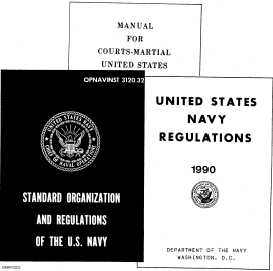Q3. What theory of punishment does the Navy use?
Q4. What two things should a recipient of Navy
punishment remember?
a.
b.
REGULATIONS THAT GOVERN THE
U.S. NAVY
Learning Objectives: When you finish this chapter,
you will be able to—
Recall various parts of the Navy Regulations and
Uniform Code of Military Justice (UCMJ)
articles.
Identify types of courts-martial, purpose of the
report of offense, and the procedures for redress
of grievance.
Figure 2-2 shows the three official sources that set
forth the basic disciplinary laws for the Navy. These
sources are the Uniform Code of Military Justice
(UCMJ) (contained in the Manual for Courts-Martial,
1995 Edition), United States Navy Regulations
(commonly called Navy Regs), and the Standard
Organization and Regulations of the U.S. Navy .
You probably have heard the saying: “Ignorance of
the law is no excuse.” This is a true saying. If it weren’t,
personnel could excuse their misconduct merely by
saying they didn’t know there was a law against it.
When you entered the Navy, you agreed to live by the
Navy’s laws and regulations. However, you do need
time to learn all the rules you must obey. You should
make every effort to learn them as soon as possible to
avoid embarrassing situations.
The U.S. Navy Regulations you must learn about are
discussed first. Then the Standard Organization and
Regulations of the U.S. Navy
and the UCMJ are
discussed.
U.S. NAVY REGULATIONS
The articles published in United States Navy
Regulations describe the principal parts of the
Department of the Navy. They also describe the duties,
authority, and responsibilities of some of the offices
within the Department of the Navy, such as the
Secretary of the Navy, the Chief of Naval Operations,
and the commanding officer. You will find the
regulations concerning the honors and ceremonies
given to civilian and military officials of the United
States and foreign governments in the Navy Regs.
U.S. Navy Regulations describe the rights and
responsibilities of all Navy members. As you become
more familiar with the regulations that govern the Navy,
you can see that they are written to protect you and to
provide guidance affecting your day-to-day routine.
The Chief of Naval Operations is responsible for
ensuring the U.S. Navy Regulations conform to the
current needs of the Department of the Navy. U.S. Navy
Regulations and changes to it are issued by the
Secretary of the Navy after being approved by the
President of the United States.
Summaries and Excerpts from Navy
Regulations
This section lists articles (with a condensation of
their text, if appropriate) from United States Navy
Regulations, 1990, that all personnel in the Navy should
know. This listing serves only as a starting place for you
to learn about Navy regulations. You are responsible
for learning and obeying all regulations. These
2-6
Student Notes:
Figure 2-2.—Three official sources for basic disciplinary laws.

